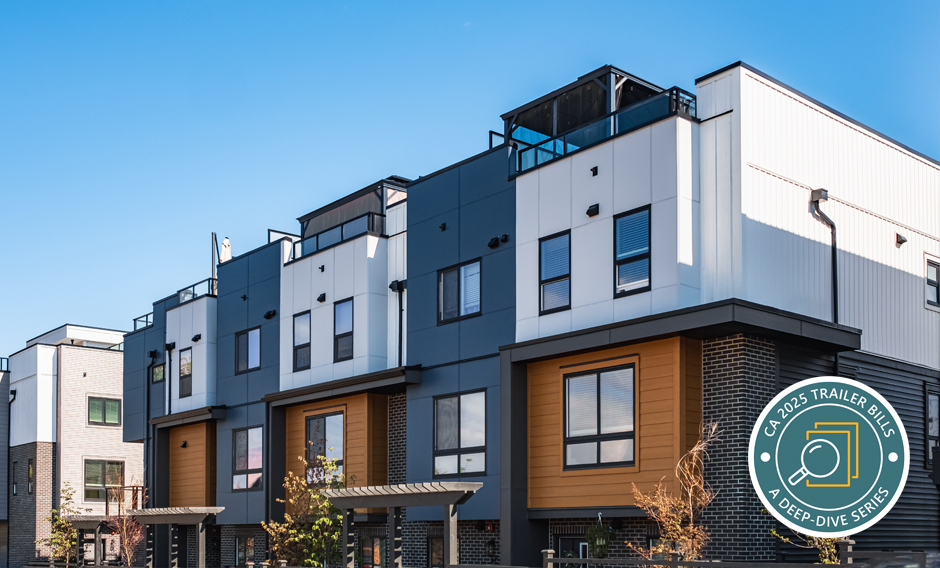Overview
California Senate Bill (SB) 131, signed into law on June 30, 2025, introduces groundbreaking reforms to the California Environmental Quality Act (CEQA) that promise to accelerate housing development statewide. Among its most innovative provisions is the “near miss” streamlined review process, codified as Public Resources Code Section 21080.1, which fundamentally changes how projects that narrowly fail to qualify for CEQA exemptions are reviewed. This provision establishes that for housing development projects which otherwise qualify for a statutory exemption or specific categorical exemption, environmental review is limited exclusively to the environmental effects caused by that disqualifying condition. It represents a pragmatic solution to a longstanding challenge in entitling housing development. It does so by relaxing CEQA compliance requirements for projects that provide much-needed residential units and are substantially similar to exempted projects, but that are prevented from using an exemption due to a single disqualifying factor. This paper presents an overview of the review requirements for near-exempt projects and offers practice insights into the bill’s application. Importantly, it should be noted that SB 131 also introduces CEQA exemptions for other types of projects, including advanced manufacturing, health centers, and food banks; however, this publication focuses solely on the new near miss provision.
CEQA Exemptions for Housing and Previous Challenges
CEQA has long provided pathways for housing projects to avoid environmental review through categorical and statutory exemptions, and as part of preliminary project review, a lead agency must evaluate whether a project qualifies for one or more exemption from CEQA. Because the new near miss provision is intended to be applied when a project misses qualifying for an existing CEQA exemption, it is important to consider the context of existing categorical and statutory exemptions to which it may apply.
Categorical Exemptions. Categorical exemptions recognize that certain “classes” of projects, as defined in CEQA Guidelines Sections 15300–15333, have typically been determined to have minimal environmental impacts. Key categorical exemptions addressed in SB 131 that may apply to housing projects include the following:
- Class 1: Existing facilities
- Class 2: Replacement or reconstruction
- Class 3: New construction or conversion of small structures
- Class 4: Minor alterations to land
- Class 5: Minor alterations in land use limitations
- Class 12: Surplus government property sales
- Class 15: Minor land divisions
- Class 20: Changes in organization of local agencies
- Class 27: Leasing new facilities
- Class 30: Minor actions to prevent, minimize, stabilize, mitigate, or eliminate release or threat of release of hazardous waste or hazardous substances
- Class 32: In-fill development projects
Many otherwise-qualifying projects are precluded from using a categorical exemption by one or more exceptions in CEQA Guidelines Section 15300.2, including:
- projects that may be in a sensitive environment that may have an environmental resource of hazardous or critical concern,
- projects that may contribute to a cumulatively significant impact,
- projects that are subject to unusual circumstances,
- projects that may result in damage to scenic resources within a state scenic highway, or
- project sites that may be listed as a hazardous waste site.
Statutory Exemptions. Statutory exemptions are created directly by the California Legislature through specific laws that explicitly exclude certain activities from CEQA requirements. The following represent select statutory exemptions and other streamlining processes related to housing that have had varying levels of effectiveness to exempt a project from further CEQA review:
- The Article 12.5 Infill Exemption (CEQA Guidelines Section 15195), which targets high-density residential infill projects, includes strict unit and site size limitations, minimum density targets that don’t necessarily align with local market conditions, geographic restrictions to urbanized areas with transit access, requirements for recent community-level environmental review, mandatory affordable housing components, and complex threshold requirements and exceptions, resulting in limited applicability.
- The “Community Plan Exemption” (CEQA Guidelines Section 15183) has become increasingly popular for avoiding redundant review when consistent with certified EIRs for general plans, community plans, or zoning actions. However, it can require extensive analysis and documentation of “peculiar” project-specific effects.
- The Sustainable Communities Exemption established by SB 375 exempts qualifying Transit Priority Projects that comply with extensive qualifying criteria including density requirements, transit proximity, and numerous land use and environmental standards.
- SB 35 established a ministerial process that requires streamlining in jurisdictions with insufficient progress toward meeting the Regional Housing Needs Assessment (RHNA) that imposes strict eligibility criteria, including locational, density, use, and affordability restrictions, that exclude many viable housing projects. While SB 35 (codified as Government Code Section 65913.4) is not technically a CEQA exemption, it does exempt qualifying projects from CEQA review by making them subject to ministerial approval.
- The new AB 130 Housing Exemption (Public Resources Code Section 21080.66) significantly expands the potential to statutorily exempt infill housing projects from CEQA that meet specific criteria related to site size and location requirements, project requirements, and environmental considerations. While it is yet to be widely tested, this exemption offers the broadest application with the fewest restrictions yet.
The “One Strike” Problem
A substantial challenge to exempting desirable projects, such as housing, from environmental review has always been that projects meeting nearly all exemption criteria would be disqualified entirely due to a single condition. This all-or-nothing approach has meant that extensive documentation and process can be required for types of projects that the Public Resources Code has predetermined to not have a significant impact on the environment. It can mean lengthy process and documentation requirements, such as preparation of EIRs including full alternatives analyses for projects failing to satisfy just one qualifying exemption criteria. This new legislation gives those projects a chance for a more streamlined review.
SB 131’s Revolutionary Solution: The “Near Miss” Provision
As noted above, Public Resources Code Section 21080.1 establishes that when a housing development project would otherwise qualify for a statutory exemption or specific categorical exemptions (Classes 1–5, 12, 15, 20, 27, 30, or 32) “but for a single condition,” CEQA review is limited exclusively to the environmental effects caused by that disqualifying condition. The legislation defines “condition” as “a physical or regulatory feature of the project or its setting or effect on the environment caused by the project,” providing necessary parameters for implementation.
Project Eligibility and Exclusions. The provision applies to housing development projects as defined in Government Code Section 65589.5, covering a broad range of residential developments. The streamlined process does not apply to residential projects that also include the following uses or characteristics:
- Warehouse distribution centers, as defined in Public Resources Code Section 21060.4
- Oil and gas infrastructure facilities used for the production, processing, transmission, storage, or distribution of petroleum or natural gas as defined in Public Resources Code Section 21064.8
- Projects on parcels exceeding 4 acres that are either builders remedy projects or are very low, low, or moderate income, or emergency shelter projects that are inconsistent with a general plan and zoning ordinance (where a jurisdiction has a compliant housing element)
- Projects located on natural and protected lands as defined in Public Resources Code Section 21067.5, including:
-
- National and State Park systems, National Monuments, National Recreation Areas, National Wild and Scenic Rivers
- Wilderness area (as defined in Public Resources Code Section 5093.32)
- Marine-protected area (as defined in Fish and Game Code Section 2852)
- Ecological reserve or wildlife management area under CDFW or conservation easement
- Hazardous waste site
- Regulated floodway or within 300 feet of a wetland
- Lands identified for conservation in an adopted HCP, NCCP, or other adopted natural resource protection plan
- Environmentally sensitive area in a coastal zone
- Very High Fire Hazard Severity Zones
- Either Prime farmland or Farmland of Statewide Importance or otherwise designated zone as protected/preserved agricultural land
Document Requirements. So, what does “limited CEQA review” look like? Depending on whether the “single condition” would result in a significant impact or less-than-significant impact, the lead agency would prepare either a negative declaration (ND), mitigated negative declaration (MND), or environmental impact report (EIR) that must:
- focus solely on effects caused by the single disqualifying condition; and
- base determinations and findings on substantial evidence in the record.
If an EIR is prepared, the analysis of project alternatives and growth-inducing impacts may be excluded. All other required contents and noticing provisions of an ND, MND, or EIR would still apply.
Enhanced Consultation Process. SB 131 also attempts to enhance the agency consultation process for private projects to facilitate more efficient project planning and review. Applicants may request pre-filing consultation with lead agencies regarding the range of potential actions, alternatives, mitigation measures, and significant environmental effects.
Practical Applications
Potential Single Condition Scenarios
The legislation’s impact will largely depend on how single condition is interpreted and applied. Such conditions fall into a few different categories: size and scale exceedances, regulatory inconsistencies, and environmental thresholds. The following represent examples of potential scenarios where projects may be excluded from exemption by a single condition.
- Size and Scale Exceedances
- A multifamily residential project in an urban area with seven dwelling units, exceeding the unit limit by one dwelling unit to qualify for a Class 3 exemption
- A mixed-use infill project on a 5.1-acre site, slightly exceeding the site size limitation, that meets all other criteria for a Class 32 exemption
- An infill project that is only surrounded by urban development on 60 percent of the perimeter rather than 75 percent of the perimeter that would normally qualify for the AB 130 infill housing exemption
- A 200-unit urban development project that is located 0.6 mile from a train station would not qualify for the Sustainable Communities Exemption because it is 0.1 mile farther away
- Regulatory Inconsistencies
- An infill project located in an unincorporated portion of a county, but just outside of city limits, that meets all other criteria for a Class 32 exemption
- An infill project that is consistent with a general plan but requires a rezone to bring the site into conformity, disqualifying the project from the 15183 Community Plan Exemption
- A 100-unit infill project on a 4-acre site that complies with all provisions of the Residential Infill Exemption in CEQA Guidelines Section 15195, except that the general plan EIR was certified 6 years ago, narrowly missing the 5-year window
- Environmental Threshold Triggers
- An infill project that would normally qualify for a Class 32 exemption but includes a portion of the site that provides biological habitat that could support special-status species
- An infill project that requires extension of new utilities but meets all other criteria for a Class 32 exemption
- An infill project that could result in significant vehicle miles traveled (VMT) impacts but could mitigate the impacts with the new provisions in Public Resources Code Sections 21080.43 and 21080.44, as established by SB 131
- Any project that would qualify for a Class 1, 2, 3, 4, 5, 12, 15, 20, 27, 30, or 32 categorical exemption that would trigger a single Section 15300.2 exception
- A project that would qualify for all provisions of SB 35 but for its location in a high fire hazard severity zone, hazardous waste site, delineated earthquake fault zone, floodplain, or floodway
- A project that would qualify for a Sustainable Communities Exemption but for its potential impacts to historic resources
Implications for Housing Development
There are several possible implications and advantages for both lead agencies and applicants from this near miss provision.
Advantages for Lead Agencies
- Resource Efficiency: Staff time and resources can be redirected from comprehensive environmental review to focused analysis of specific impacts.
- Clear Decision Framework: The provision provides a structured approach for handling projects that previously fell into regulatory gray areas.
- Housing Production Goals: Local and state housing objectives are supported by removing barriers to viable projects.
Benefits for Project Proponents
- Accelerated Timelines: Reduced CEQA documentation requirements will significantly shorten processing times, potentially reducing approval periods from years to months.
- Cost Reduction: Limited environmental review translates to substantial savings in consultant costs, technical studies, and administrative expenses.
- Reduced Scope of Legal Challenge: A narrower scope of environmental analysis provides fewer targets for legal challenges. However, that may have to be seen as there may be some initial litigation to clarify parts of the law.
- Design Flexibility: Projects can be optimized for housing production without being artificially constrained by rigid exemption criteria.
Implementation Uncertainties and Best Practices
Implementation Uncertainties
As described above, a quick review of the potential applications of this provision yields numerous examples of project types that could benefit from SB 131’s streamlined CEQA review provision. However, several aspects of the provision remain open to interpretation and will likely require clarification through practice and potentially by the courts.
For project site scale and size exceedances, it can be assumed that projects will be held strictly to exemption requirements. For instance, where a project exemption is limited to six units, seven units would represent a single condition deviation. And for projects proposing to develop a 10-acre site where an exemption limits site size to 5 acres, the project would be disqualified. However, where the qualifying condition is the site’s size or number of units, what would be the scope of the analysis for the limited review allowed under the near miss provision? Is it the impact of the one extra unit or the 5 extra acres?
What about the scope of the analysis when the single disqualifier is that a project may contribute to a cumulatively significant impact? Would the analysis be limited to the single-issue area in which the cumulative impact would occur? And what would the cumulative analysis be based on if there’s no other project analysis?
And how do you focus the analysis for a project that could result in a significant impact due to unusual circumstances—can this be limited to a single-issue analysis? Or evaluate a project that is not fully surrounded by urban development? How does the limited environmental review evaluate the impacts associated with those conditions?
Ultimately, the near miss provision appears most readily applicable when the single disqualifying condition is an environmental condition. For instance, if a project would trigger an environmental threshold, such as an impact on a historic resource or on habitat for a special-status species, the analysis could easily be focused on that one issue for the entire project. However, what about if a project misses qualifying for an exemption by one condition and that condition relates to a series of site characteristics, such as AB 130’s requirement that a project satisfies the requirements specified in paragraph (6) of subdivision (a) of Section 65913.4 of the Government Code, which includes numerous environmental conditions, including being located in a very high fire hazard severity zone, being located in a special flood hazard area, or including wetlands or habitat for a special-status species. Is the single condition the satisfaction of the code requirements, or is each environmental characteristic a condition? In this case, the answer is likely the latter, since the statute defines “condition” as a “physical or regulatory feature of the project or its setting or an effect upon the environment caused by the project.” But still, it begs the question.
Best Practices
The uncertainties identified above likely just scratch the surface of the questions that will emerge as agencies and applicants work to decipher how to best take advantage of this new CEQA provision. As such, there are several recommended steps for lead agencies and project applicants to take when considering potential qualifying projects.
Lead agencies should:
- develop standardized procedures for identifying and processing near miss projects,
- create templates for limited environmental review documentation,
- establish clear criteria for determining when conditions qualify as single condition disqualifiers,
- coordinate with legal counsel on interpretation guidelines,
- provide staff training on new streamlining opportunities, and
- consider how SB 131 can work in tandem with other new legislation such as AB 130, which created a new statutory exemption for infill housing projects; projects that don’t qualify for AB 130’s new exemption, but for one condition, may still benefit from SB 131’s limited review process.
Project applicants should:
- conduct early analysis to identify potential near miss opportunities,
- document conformance with all exemption criteria except the single disqualifying condition,
- prepare focused technical studies addressing the specific disqualifying condition, and
- use pre-filing consultation processes to clarify review scope and requirements.
Conclusion: A Pragmatic Step Forward
California SB 131’s near miss provision represents a pragmatic evolution in CEQA implementation that acknowledges the need to expedite housing development while adhering to the spirit of CEQA. By focusing environmental review on actual areas of concern rather than requiring comprehensive analysis for projects that are substantially similar to exempt projects, the provision promises to:
- reduce unnecessary delays in housing approval,
- lower development costs that ultimately impact housing affordability,
- maintain meaningful environmental review where it matters most, and
- support California’s broader housing production goals.
Implementation of SB 131, and specifically the near miss provision, also could have broader policy implications, such as paving the way for further CEQA reform through additional streamlining measures. Once the kinks are worked out and agencies and their consultants grow more confident in using this new provision, the hope is that it goes a long way toward increased housing production and affordability.
The provision’s ultimate success will depend largely on consistent and aggressive interpretation and implementation across jurisdictions, as well as its ability to withstand legal scrutiny. Early interpretation and application of the provision will be critical to establishing precedents and best practices that maximize its potential to accelerate housing development while preserving environmental protections.


